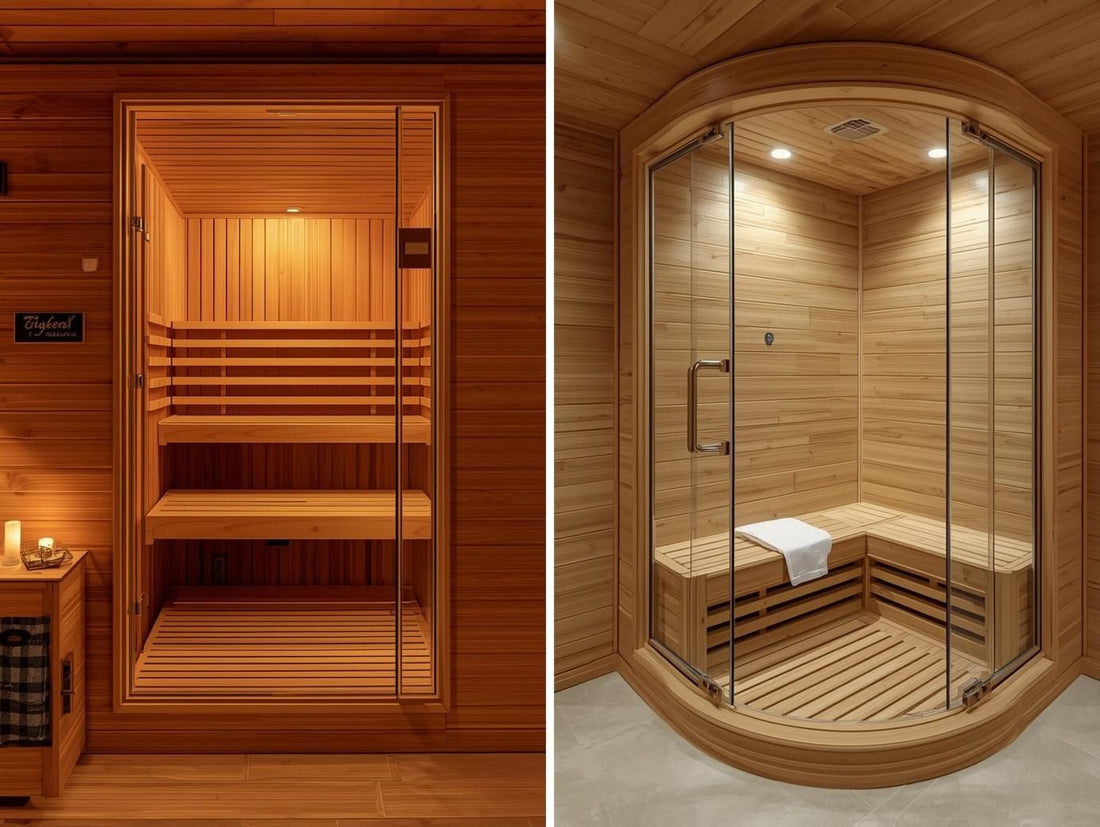Key Takeaways
· Steam rooms use moist heat from boiling water to improve relaxation and circulation.
· Saunas provide dry heat that promotes deeper muscle relief and detoxification.
· The main difference is humidity — steam rooms are wet and soothing, while infrared saunas deliver deep, dry heat for enhanced recovery and wellness.
What’s the Difference Between a Steam Room and a Sauna?
A steam room uses moist heat from boiling water, while a sauna provides dry heat that can come from infrared, wood, or electric sources. The main difference is humidity — steam rooms are wet and soothing, while saunas are hot and dry, providing deeper heat therapy.
Steam Room Basics:
· Temperature: 100–114°F
· Humidity: Nearly 100%
· Benefits: Respiratory relief, hydration for skin, and relaxation
Sauna Basics:
· Temperature: 160–195°F
· Humidity: 10–20% (depending on type)
· Benefits: Deep muscle relief, detox, and circulation improvement
For those comparing infrared sauna vs traditional sauna, infrared options use light to directly heat the body, creating intense warmth without overwhelming humidity.
What Are the Health Benefits of Saunas and Steam Rooms?
Both steam rooms and best infrared sauna for home provide remarkable physical and mental health benefits.
Regular sessions in a sauna or steam room can improve circulation, reduce stress, boost recovery, and support detoxification. The heat stimulates blood flow, eases muscle tension, and helps remove impurities from the skin, leaving you feeling refreshed and rejuvenated.
Key Benefits:
1. Cardiovascular Health: Improved circulation supports heart health and lowers blood pressure.
2. Stress Relief: Both lower cortisol levels, promoting relaxation and focus.
3. Pain Relief: Heat helps relieve sore muscles and joint stiffness.
4. Detoxification: Sweating removes toxins and supports immune function.
5. Skin Health: Opens pores to clear dirt and dead skin cells.
If you’re focused on cleansing and wellness, the infrared sauna benefits detox process is especially effective because it heats your body’s core temperature, helping eliminate toxins more deeply than traditional steam.
How Do Steam Rooms and Saunas Affect the Immune System?
Spending time in heated environments like saunas or steam rooms mimics a mild fever response, signaling your immune system to activate. This process enhances the body’s natural defense mechanisms, helping you fight off infections and maintain better overall wellness.
The infrared sauna health benefits include boosting white blood cell production, improving recovery, and supporting longevity through gentle heat exposure.
Which Should You Choose — Steam Room or Sauna?
The choice depends on your comfort and wellness goals. If you prefer dry heat and deep muscle therapy, a sauna — especially a full-spectrum infrared sauna — may be best. If you enjoy moist heat for respiratory relief and hydration, a steam room is ideal.
Factors to Consider:
· Respiratory Relief: Steam rooms help with congestion and breathing issues.
· Muscle Recovery: Infrared saunas penetrate muscle tissue more effectively.
· Temperature Preference: Saunas reach higher heat levels, while steam rooms feel gentler.
· Maintenance: Saunas are easier to maintain for home infrared sauna installation.
Wondering which is better indoor or outdoor sauna? Indoor models offer privacy and temperature control, while outdoor saunas connect you to nature and are perfect for scenic relaxation.
Are Home Saunas Safe for Health?
Yes, when used responsibly, home saunas are safe and beneficial. Limit sessions to 20–30 minutes, stay hydrated, and listen to your body. Avoid use if you’re ill or have cardiovascular issues unless approved by your doctor.
Modern infrared saunas are designed with safety in mind, offering controlled heat and low EMF technology for worry-free wellness.
How Much Does an Infrared Sauna Cost?
The infrared sauna price depends on size, features, and quality. Home models range from a few thousand dollars for compact units to premium full-spectrum designs for multi-person use. Investing in a sauna adds long-term health value and enhances your home wellness routine.
FAQs
1. What is a full-spectrum infrared sauna?
A full-spectrum infrared sauna uses near, mid, and far infrared wavelengths to heat your body from within, promoting deep relaxation and detoxification. It’s more efficient than traditional saunas and ideal for daily home wellness.
2. How often should you use an infrared sauna?
Most experts recommend using an infrared sauna three to four times a week for optimal results. Start with shorter 10–15-minute sessions and gradually increase as your body adapts.
3. Do infrared saunas help with weight loss?
Yes. Regular infrared sauna use can increase heart rate and calorie burn, supporting a healthy metabolism. However, it should complement diet and exercise rather than replace them.
4. Which is better: indoor or outdoor sauna?
An indoor sauna offers year-round comfort and convenience, while an outdoor sauna provides a nature-immersive experience. Both deliver the same wellness benefits — the choice depends on your space and preferences.
5. Are home saunas safe for daily use?
Yes, home saunas are safe for regular use if you stay hydrated and keep sessions moderate. Avoid alcohol before using a sauna and consult your doctor if you have health conditions.
Final Thoughts
Choosing between a steam room and a sauna depends on your needs — steam rooms provide moist heat for respiratory relief, while infrared saunas deliver deep, therapeutic warmth for detox, recovery, and relaxation. At SunHome Saunas, we’re passionate about helping you create the perfect home wellness experience. Explore our selection of indoor saunas, outdoor saunas, and full-spectrum infrared saunas for sale designed to fit every lifestyle. Whether you’re upgrading your self-care routine or exploring home infrared sauna installation, our expert team is here to guide you every step of the way.






